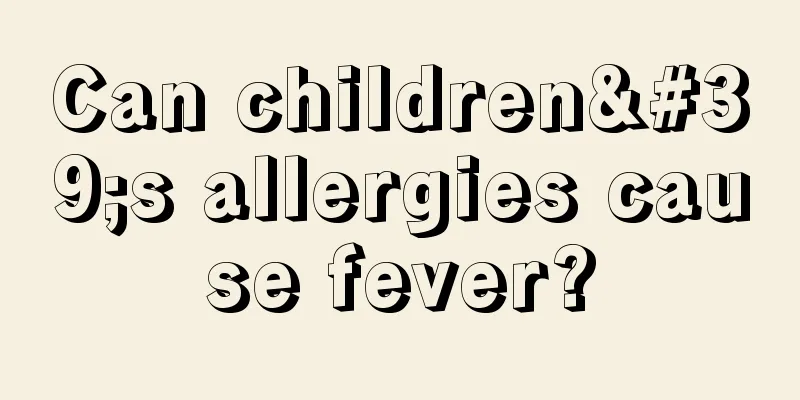Can children's allergies cause fever?

|
In fact, most cases of allergies will not cause fever, unless the allergy is caused by a viral infection or a bacterial infection. If this is the case, a fever may occur. This situation will become more common in children, so if it occurs, parents should give them medication in time to relieve the symptoms. Fever is caused by the action of fever activators on the body, which in turn leads to the production of endogenous pyrogens (EP) and enters the brain to act on the body temperature regulation center, which in turn leads to the release of fever center mediators, which in turn causes a change in the set point and ultimately causes fever. Common fever activators include exogenous pyrogens from outside the body: bacteria, viruses, fungi, spirochetes, malarial parasites, etc.; and those from inside the body: antigen-antibody complexes, steroids, etc. Endogenous pyrogens (EP) come from EP-producing cells in the body, and their main types include: interleukin-1 (IL-1), tumor necrosis factor (TNF), interferon (IFN), interleukin-6 (IL-6), etc. EP acts on the body temperature regulation center located in the POAH, resulting in the production of positive and negative regulatory mediators. The latter may cause a change in the set point and ultimately lead to the generation of heat. Fever itself is not a disease, but a symptom. In fact, it is one of the body's mechanisms for fighting infection. Fever may even have its uses: shortening the duration of illness, enhancing the effectiveness of antibiotics, and making infections less contagious. These abilities should offset the discomfort experienced when having a fever. The etiology of fever of unknown origin (FUO) is a global problem, and the cause of nearly 10% of FUO cases remains unknown. Fever itself can be caused by many types of diseases, such as infection, tumors, autoimmune diseases and blood diseases, and cannot be clearly classified. In the past, such patients were usually diagnosed and treated by internal medicine physicians, and in most hospitals with more specialized specialties, they were mainly treated by respiratory physicians. Currently, many hospitals have opened infection departments and FUO is classified as such in the infection departments. This specialized management is an improvement and can improve the level of diagnosis and treatment. FUO has a precise definition, which includes 3 key points: ① Fever lasts for ≥ 3 weeks; ②Body temperature > 38.3℃ for many times; ③ The diagnosis cannot be confirmed after ≥ 1 week of complete medical history, physical examination and routine laboratory tests. It can be seen that although FUO itself is a symptom diagnosis rather than a disease diagnosis, the diagnostic requirements are very strict. |
<<: What to do if a child has a fever of 375
>>: Why does my child have a stomachache and fever?
Recommend
What is the difference between whooping cough and other coughs?
The symptoms of whooping cough are becoming more ...
A Complete Spring Recipe for Children to Grow Taller
Spring is the best time for children to grow, so ...
Can children’s vaccinations be postponed?
We all know that there are time limits for baby v...
Eight-year-old child wets the bed
The bed-wetting problem of newborn babies is a ve...
What should teenagers pay attention to when taking calcium tablets to promote bone growth?
For many growing children, parents often buy calc...
Is garlic effective in treating children's cough?
Garlic plays many roles in our lives. Not only do...
Children's lower eyelid redness and swelling
As the saying goes, eyes are the windows to the s...
Treatment of acute otitis media in children
For children, it is necessary to continuously inc...
The role of acupuncture in the treatment of cerebral palsy in children
Cerebral palsy in children is currently a common ...
Children's brain-boosting foods
Dark leafy greens The metabolism of protein foods...
What to do if baby has blisters on feet due to eczema
Eczema is a relatively common skin disease. The b...
What should I do if my child has pain when urinating?
When your child encounters pain when urinating, y...
What to do if your 9 month old baby has a low fever
At the nine-month stage, the baby's body resi...
Can a newborn be rocked?
In our lives, many mothers will rock their babies...
Why does my baby always make the sound of swallowing saliva?
We all have this experience, that is, we hear the...









